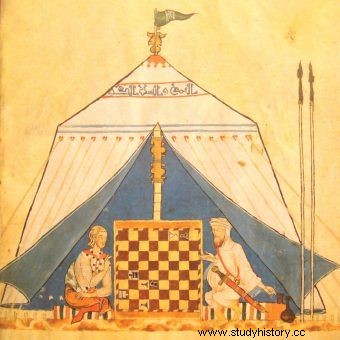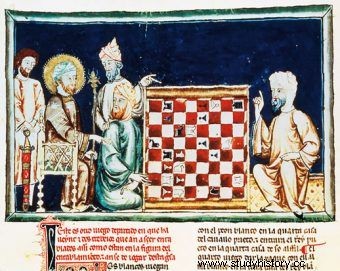Medieval inhabitants of Europe knew that chess came from the Far East. In the minds of many, wonderful stories related to their origins have appeared. Figures were attributed with magical powers and fantastic abilities. The game became more and more popular despite opposition from the Church.
This game known to us came from distant India. Medieval Europe first received it from Muslim merchants crossing the Mediterranean trade route, probably in the middle of the 10th century. Less than a century later, chess found its way to the northern regions of the continent thanks to Scandinavian merchants trading in the regions of the Byzantine Empire. It was present everywhere - in churches, at royal courts, in taverns, houses and streets.
The oriental origins of the game meant that medieval authors ascribed many legends and stories to the creation of chess, e.g. they saw the invention of the game by the ancient Greeks - Aristotle, or the mythological cousin of Menelaus - Palamedes, who was to invent chess under the walls of Troy . In turn, the medieval Palamedes - a knight of the Round Table, son of a Sultan who came to Europe and became a Christian - taught other knights to play chess. He even received a coat of arms with a checkered shield (such coats of arms quickly became popular among European families). All these legends became incredibly popular in the late Middle Ages, and the names and coats of arms of literary characters were readily accepted in court circles.
Popularity and Symbolism
Chaturanga appeared in India in the 5th century . It was a four-player game that mirrored the skirmishes. The player could control the vizier, elephants, chariots and also infantry. Each figure moved on its spaces (it was a tactical element), and the players rolled dice that indicated the number of spaces to be moved. The game in Arab countries had figures that did not represent characters (forbidden by the Koran). Initially, it did not arouse admiration in Europe, as it was considered too difficult. Over time, however, it has become the most appreciated and popular entertainment.

Chess quickly became a popular pastime
The Europeanization of chess had a very positive effect on the spread of chess. The figures so far were not very interesting, so it was decided to replace them more with the realities of feudal Europe. The game of chess represented a battle, not a war, which for the people of the early Middle Ages was quite a problem in the way of understanding the game. In the 11th and 12th centuries, they did not know the real battles well. Everyday there was war, frequent raids, smaller clashes, chases etc. It was only in the 12th and 13th centuries that the situation changed, because Christian knights began to fight battles with the infidels. And that was definitely more like a chess match.
Chess pieces were another issue. The pawn and the horse were clearly legible, worse with the vizier (royal adviser). He was transformed into a queen. However, it caused a problem, because a pawn can become a queen during the game, and a Christian ruler should not have several wives. These "multiplied" royal wives were called ladies to get around this problem. The figure of the elephant also raised doubts. The Arabs kept it, but they did not represent it literally, but as, for example, two protruding fangs. The Europeans did not really understand what this procedure was about and they looked for other meanings of the figure - tree, jester or bishop's hat . Eventually, in the 15th century, the figure of the tower was adopted. The movements of the figures were also accelerated, and over time their importance on the board was expanded or decreased. It all depended on the game's adaptation to the realities of the terrain on which it was played. In the 16th century, chess took the shape we know today.

Chess came to Europe through Arab merchants
The game came to our country from Kievan Rus, the Czech Republic and via trade routes in the Baltic Sea. Our country took over the traditions of both cultures - western and eastern. To this day, the nomenclature of the queen is used alternately with the queen.
Church and statues
The church considered chess a diabolical game , he condemned it mainly in the 11th and 12th centuries. Towards the end of the Middle Ages, the attitude to this game became more forgiving, as chess entered court and chivalry culture. Also the changes that have come to the Europeanized chess - removal of the dice - made the Church look at her more favorably. Dice is a gamble, and the one for the Church was bad, deterrent and associated with the devil . On the other hand, cathedrals and abbeys were happy to keep chess in their vaults. The explanation for this phenomenon is the then manifestation of power by a king, a prince, and even an abbot. Having beautifully decorated figures was of great value, they were not only used for the game, but also became an indicator of the prestige and value of a given treasury and the person to whom the treasury belonged.

Queen's figure made of ivory
Figures made of magnificent materials by Eastern artisans made them ascribed magical properties too. . They were preferably made of ivory. For those times, this material was comparable to gold, it was very rare, and additionally had healing properties and talisman functions . However, ivory is a road material, so it was willingly exchanged for deer antlers, bull horns or cetacean bones . In the 15th century, amber, coral, wax or wood were also used . The bones of animals reflected the "aggressiveness" in the game, introducing a kind of metaphysics in the sense of chess games (mainly in the feudal period), while the figures made of organic materials were closer to the Bible (plant origin is more pure). It has always been believed, however, that the pieces come to life on the chessboard. It all permeated the culture. François Rabelais in his famous work "Gargantua and Pantagruel" presents a ball at which a game of chess takes place . The figures are actors walking on the great chessboard.
Although today a game of chess can be played on a computer, they still evoke emotions and even this has not deprived them of a certain magic that still inspires players and artists.
Bibliography:
- Ealesa R., Chess. The History of a Game, London 1985.
- François Rabelais, "Gargantua and Pantagruel", Krakow 2003.
- Giżycki J., Litmanowicz W., "Chess from A to Z", vol. I, Warsaw 1986.
- Murray J. R. H., A History of Chess, Oxford 1913.
- Sołtysiak M, Archeology of chess:contribution to the study of cultural changes concerning the position of women in the Middle Ages on the example of the transformation of the figure of a vizier into a queen, [In:] Homo Ludens:ludological journal of the Polish Society for Game Research, 2014.
